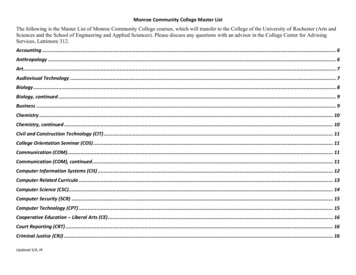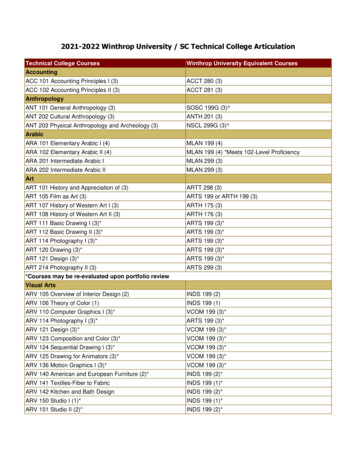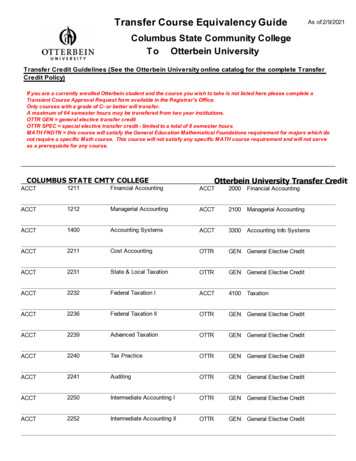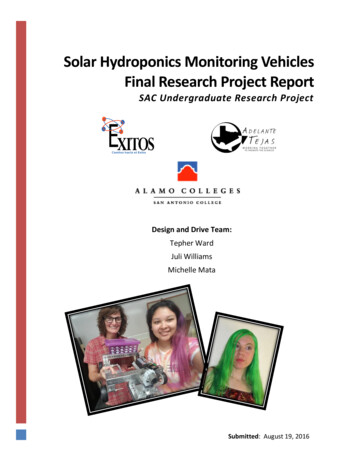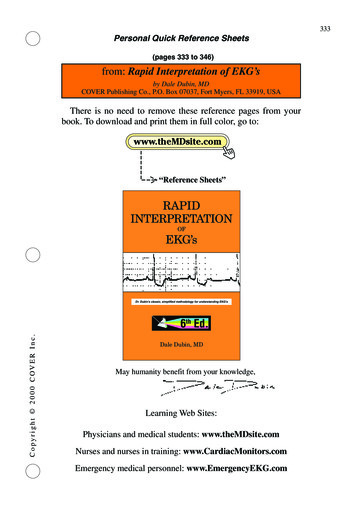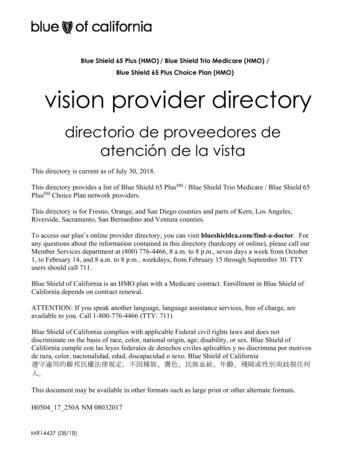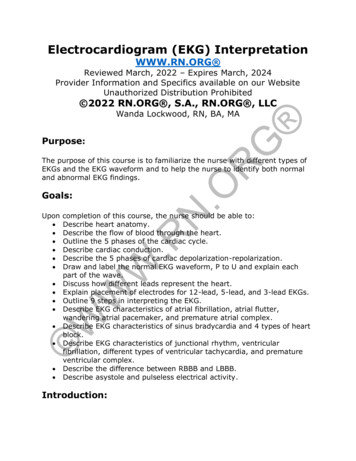
Transcription
SHIELD-EKG-EMG bio-feedback shieldUSER’S MANUALAll boards produced by Olimex LTD are ROHS compliantRevision E, June 2014Designed by OLIMEX Ltd, 2011
OLIMEX 2014SHIELD-EKG-EMG user's manualDISCLAIMER 2013 Olimex Ltd. Olimex , logo and combinations thereof, are registered trademarks of Olimex Ltd. Otherproduct names may be trademarks of others and the rights belong to their respective owners.The information in this document is provided in connection with Olimex products. No license, express orimplied or otherwise, to any intellectual property right is granted by this document or in connection withthe sale of Olimex products.This work is licensed under the Creative Commons Attribution-ShareAlike 3.0 Unported License. To view acopy of this license, visit .This hardware design by Olimex LTD is licensed under a Creative Commons Attribution-ShareAlike 3.0Unported License.The software is released under GPL.It is possible that the pictures in this manual differ from the latest revision of the board.The product described in this document is subject to continuous development and improvements. All particularsof the product and its use contained in this document are given by OLIMEX in good faith. However allwarranties implied or expressed including but not limited to implied warranties of merchantability or fitness forpurpose are excluded. This document is intended only to assist the reader in the use of the product. OLIMEXLtd. shall not be liable for any loss or damage arising from the use of any information in this document or anyerror or omission in such information or any incorrect use of the product.This evaluation board/kit is intended for use for engineering development, demonstration, or evaluation purposesonly and is not considered by OLIMEX to be a finished end-product fit for general consumer use. Personshandling the product must have electronics training and observe good engineering practice standards. As such,the goods being provided are not intended to be complete in terms of required design-, marketing-, and/ormanufacturing-related protective considerations, including product safety and environmental measures typicallyfound in end products that incorporate such semiconductor components or circuit boards.Olimex currently deals with a variety of customers for products, and therefore our arrangement with the user isnot exclusive. Olimex assumes no liability for applications assistance, customer product design, softwareperformance, or infringement of patents or services described herein.THERE IS NO WARRANTY FOR THE DESIGN MATERIALS AND THECOMPONENTS USED TO CREATE SHIELD-EKG-EMG. THEY ARECONSIDERED SUITABLE ONLY FOR SHIELD-EKG-EMG.Page 2 of 20
OLIMEX 2014SHIELD-EKG-EMG user's manualWARNING:EKG DEVICE DISCLAIMERIEC601 is a standard that specifies tests and requirements that medical devicesmust pass before they can be used on humans. However, none of the devicesbuilt from these designs have been tested according to these guidelines becauseof the costs involved. Therefore, a device based on any of these designs may notbe used for medical purposes as no medical claims are made.NOTE THAT CONNECTING A DEVICE VIA ELECTRODES TOHUMANS OR ANIMALS IS POTENTIALLY HAZARDOUS AND MAYRESULT IN ELECTRIC SHOCK AND/OR SEIZURE.Page 3 of 20
OLIMEX 2014SHIELD-EKG-EMG user's manualTable of ContentsDISCLAIMER.2SECTION 1 OVERVIEW.51.1 Scope.51.2 Features.51.3 Similar boards.51.4 Organization.6SECTION 2 SETTING UP THE SHIELD-EKG-EMG.72.1 Electrostatic Warning.72.2 Requirements.72.3 Powering up the board.82.4 Arduino/Maple/Pinguino note.8SECTION 3 SHIELD-EKG-EMG BOARD DESCRIPTION.103.1 Layout (Top view):.103.2 Layout (Bottom view):.11SECTION 4 INSTALLATION EXAMPLE.124.1 SHIELD-EKG-EMG and OLIMEXINO-328.12SECTION 5 HARDWARE.145.1 Arduino shield connector.145.2 Trimmer TR1.145.3 Jumper description.145.4 Custom electrode connection.16SECTION 6 SCHEMATICS.176.1 Eagle schematics.176.2 Physical dimensions.19SECTION 7 REVISION HISTORY.207.1 Document revision.207.2 Web page of your device.207.3 Ordering info.20Page 4 of 20
OLIMEX 2014SHIELD-EKG-EMG user's manualSECTION 1 OVERVIEWThank you for choosing the SHIELD-EKG-EMG prototype board from Olimex! Thisdocument provides a User’s Guide for the Olimex SHIELD-EKG-EMG. As an overview, thischapter gives the scope of this document and lists the board’s features. The document’sorganization is then detailed.1.1 ScopeThe SHIELD-EKG-EMG is an extension module for Olimex's ARDUINO compatible boards– like OLIMEXINO-328, OLIMEXINO-STM32 and PIC32-PINGUINO, among others. Theshield is also compatible with ARDUINO boards including ARDUINO UNO. The boardcomes with mounted connectors on it.1.2 Features Suitable for electrocardiography – monitoring and data collectionSuitable for electromyography – monitoring and data collectionStackable shield (pass-through headers) - up to 6 shields forming 6 channels; mountedon top of each other and wired to A0-A6 analogue inputsOpen hardware, open software project – users have access to all design documentsCalibration signal generation by D4/D9 digital outputPrecise trimmer potentiometer for calibration (all boards are shipped completely assembled, tested and calibrated so you should not do this unless you wat to see howthings work)Input connector for passive or active electrodesWorks with both 3.3V and 5V Arduino boardsAvailable examples for Arduino, Pinguino and MaplePlease note that the unit can be used for electroencephalography to some extent, however suchuse is not intended by design. The design doesn't provide the accuracy required for properEEG and if you are interested in this field, please, consider the EEG-SMT board.1.3 Similar boardsEEG-SMT – an inexpensive unit specifically designed for electroencephalography (EEG) recording of electrical activity along the scalp (brain EEG/EEG-SMT/PROTO-SHIELD – If you seek a board which follows the DUINO shield dimensionsspecification and offers prototype area and 2 buttons with filter capacitors and 2 LEDs. Webpage of the product: O-SHIELD/SHIELD-LOL – If you are searching for a shield with 126 LED matrix (14 9) available in 4colors and 4 different sizes of the LEDs. Web /SHIELD-LOL/Page 5 of 20
OLIMEX 2014SHIELD-EKG-EMG user's manual1.4 OrganizationEach section in this document covers a separate topic, organized as follow:-Section 1 is an overview of the board usage and features-Section 2 provides a guide for quickly setting up the board and introduces the user toArduino/Maple/Pinguino-Section 3 contains the general board diagram and layout-Section 4 show and example of setting up SHIELD-EKG-EMG with OLIMEXINO-328-Section 5 covers the connector pinout, peripherals and jumper description-Section 6 provides the schematics-Section 7 contains the revision historyPage 6 of 20
OLIMEX 2014SHIELD-EKG-EMG user's manualSECTION 2 SETTING UP THE SHIELD-EKG-EMGThis section helps you set up the SHIELD-EKG-EMG development board for the first time.Please consider first the electrostatic warning to avoid damaging the board, then discover thehardware and software required to operate the board.The procedure to power up the board is given, and a description of the default board behavioris detailed.2.1 Electrostatic WarningThe SHIELD-EKG-EMG development board is shipped in a protective anti-static package.The board must not be exposed to high electrostatic potentials. A grounding strap or similarprotective device should be worn when handling the board. Avoid touching the componentpins or any other metallic element.2.2 RequirementsIn order to set up the SHIELD-EKG-EMG prototype board, the following items are required:- SHIELD-EKG-EMG itself- ARDUINO compatible board* (e.g. OLIMEXINO-328, OLIMEXINO-STM32, PIC32PINGUINO)- Electrode cable***The pinout for the board strictly follows the DUINO extension specification. Best choice fora board would be OLIMEXINO-328 or any DUINO board which utilizes the ATmega328since we have working and tested examples for those MCUs, configuring them forATmega128 would require tweaking of the code.**The cable features three electrodes – two data electrodes (1 channel) and DLR electrode(feedback). If you use more than one SHIELD-EKG-EMG you can use cables without DLRfor every shield after the first.IMPORTANT NOTE: The electrode cables for SHIELD-EKG-EMG and MOD-EEG-SMTare different and not compatible!There are two electrode cables that we have tested with the board. They are named SHIELDEKG-EMG-PA and SHIELD-EKG-EMG-PRO. The first one is considered open-hardwareand its schematics might be used as a reference if you wish to make the cable yourself.The SHIELD-EKG-EMG-PRO works with different set of attachment cups that makes iteasier to measure EMG signals at hard-to-reach spots and also allow contact materialsreplacement.Links to the web-pages of the electrodes:- LD-EKG-EMG-PA/open-sourcePage 7 of 20
OLIMEX 2014SHIELD-EKG-EMG user's manualhardware- LD-EKG-EMG-PRO/Different pads for SHIELD-EKG-EMG-PRO electrode:- k/ECG-GEL-ELECTRODE/- CLIP/- SCUP/In case you want to build a working SHIELD-EKG-EMG system without owning a DUNIOboard the best choice would be our board OLIMEXINO-328. This is the web page for theboard: O-328/.2.3 Powering up the boardThe SHIELD-EKG-EMG board is powered by the host board it is mounted on. There is theoption to be powered either by 3.3V or 5.0V host board (configured easily by a jumper).On powering the board PWR LED must become RED.2.4 Arduino/Maple/Pinguino noteWhat is Arduino?Arduino is an open-source electronics prototyping platform, designed to make the process ofusing electronics in multidisciplinary projects more accessible. The hardware consists of asimple open hardware design for the Arduino board with an Atmel AVR processor and onboard I/O support. The software consists of a standard programming language and the bootloader that runs on the board.Arduino hardware is programmed using a Wiring-based language (syntax libraries), similarto C with some simplifications and modifications, and a Processing-based IntegratedDevelopment Environment (IDE).The project began in Ivrea, Italy in 2005 aiming to make a device for controlling student-builtinteraction design projects less expensively than other prototyping systems available at thetime. As of February 2010 more than 120,000 Arduino boards had been shipped. FoundersMassimo Banzi and David Cuartielles named the project after a local bar named Arduino. Thename is an Italian masculine first name, meaning "strong friend". The English pronunciationis "Hardwin", a namesake of Arduino of Ivrea.More information could be found at the creators web page http://arduino.cc/ and in theArduino Wiki http://en.wikipedia.org/wiki/Arduino.To make the story short – Arduino is easy for beginners who lack Electronics knowledge, butalso does not restrict professionals as they can program it in C or mix of Arduino/C language.There are thousands of projects which makes it easy to startup as there is barely no fieldPage 8 of 20
OLIMEX 2014SHIELD-EKG-EMG user's manualwhere Arduino enthusiasts to have not been already.Arduino has inspired two other major derivatives – MAPLE and PINGUINO. Based on 8-bitAVR technology the computational power of Arduino boards is modest, this is why a teamfrom MIT developed the MAPLE project which is based on ARM7 STM32F103RBT6microcontroller. The board have same friendly IDE as Arduino and offers the samecapabilities as hardware and software but runs the Arduino code much faster. The Mapleproject can be found at http://leaflabs.comIn parallel with Arduino another project was started called PINGUINO. This project chose itsfirst implementation to be with PIC microcontrollers, as AVRs were hard to find in some partsof the world like South America so it is likely to see lot of PINGUINO developers are fromthat part of the world. PINGUINO project founders decided to go with Python instead Javafor processing language. For the moment PINGUINO is much more flexible than Arduino asit is not limited to 8bit microcontrollers. Currently the IDE, which has GCC in background,can support 8-bit PIC microcontrollers, 32bit PIC32 (MIPS) microcontrollers andARM7/CORTEXM3 microcontrollers which makes PINGUINO very flexible because onceyou make your project you can migrate easily through different hardware platforms and notbeing bound to a single microcontroller manufacturer. The PINGUINO project can be foundat: http://www.pinguino.cc.Page 9 of 20
OLIMEX 2014SHIELD-EKG-EMG user's manualSECTION 3 SHIELD-EKG-EMG BOARD DESCRIPTIONHere you get acquainted with the main parts of the board. Note the names used on the boarddiffer from the names used to describe them. For the actual names check the SHIELD-EKGEMG board itself.For example: BUTTON (seen on the op view below) is named BUT; RESET is named RST;etc3.1 Layout (Top view):Page 10 of 20
OLIMEX 2014SHIELD-EKG-EMG user's manual3.2 Layout (Bottom view):Page 11 of 20
OLIMEX 2014SHIELD-EKG-EMG user's manualSECTION 4 INSTALLATION EXAMPLEThis is a step by step example of installing SHIELD-EKG-EMG on OLIMEXINO-328 usingWindows. You can refer to the tips keeping in mind that the example utilizes a board withATmega328 MCU.4.1 SHIELD-EKG-EMG and OLIMEXINO-328In this example we use OLIMEXINO-328; SHIELD-EKG-EMG; USB – USB mini cable;Arduino 1.0 IDE; two external libraries for the IDE (the latest versions of TimerOnev9 andFlexiTimer2); the latest FTDI VCP drivers (2.08.14), demo code provided by us that can bedownloaded from the web site and free monitoring software Electric Guru.0. IMPORTANT! Before starting you have to prepare the OLIMEXINO-328 board byremoving its wire between the R6 pads (R6 is not mounted). There is increased powerconsumption and a chance of electrical failure if you omit to do so. This is only for theOLIMEXINO-328 board! Don't do the modification if you lack basic electronics skills,because it is possible to damage the board.If the host board provides reference voltage on the AREF pin then open REF E jumper. Wedon't want two supplies to provide power to the same line – the 3V REF ADC one.1. Download and extract the Arduino 1.1 IDE package from the Arduino web site:http://www.arduino.cc/2. Download and place the two timer libraries required (TimerOne, FlexiTimer2) in\arduino-1.0\libraries by placing each of them in properly named folder (check theother libraries for http://www.pjrc.com/teensy/td libs MsTimer2.html3. Download the demo project from product’s web /SHIELD-EKG-EMG/4. Download the FTDI VCP drivers: http://www.ftdichip.com/Drivers/VCP.htm5. Set the jumpers of SHIELDEKG-EMG in the followingway:REF E – closed3.3V/5V – 5V positionD4/D9 – D9 positionANI SEL – 1 position (channel)6. Connect the shield to theboard7.Connect OLIMEXINO-328 tothe USB8. Install the VCP FTDI drivers by going in Device Manager; right-clicking over thePage 12 of 20
OLIMEX 2014SHIELD-EKG-EMG user's manualunrecognized device and choosing Update Driver and then pointing to the folderwhere you downloaded and extracted the FTDI VCP driver.Here it is advisable to go to Device Manager and from advanced settings of ourrecognized USB Serial Port (COMx) device to set x to a free port between 1 and 4(because the monitoring software in this example can read only from COM ports 1 to4).9. Start Arduino IDE and open the provided by Olimex projectShieldEkgEmgDemo.pde10. Set Tools - Board - Arduino Duemilanove w/ ATmega328Set Tools - Serial port - the COM we configured our board at11. Click Upload ( )12. Download, install and start the software from this EG-SMT/resources/ElecGuru40.zip13. It is advisable to adjust the settings in your ElecGuru program in Preferences- Trace (waveform) (depending how many channels/shields you use)14. Choose the COM port your OLIMEXINO is connected to from Preferences - Serial port (Remember you have to set it to COM 1 to 4)15. You connect the electrodes to your right arm, left arm and the DLR to your rightleg16. Start monitoring, adjust the settings until you receive an image like the one shownon the picturePage 13 of 20
OLIMEX 2014SHIELD-EKG-EMG user's manualSECTION 5 HARDWAREYou can get a good view of the hardware observing the board. All pins, connectors andjumpers are named individually.5.1 Arduino shield connectorThese connectors follow the ARDUINO specification for shield connection. The shield comeswith soldered connectors making it ready for mounting on compatible board with thepossibility to have another shield mounted on it.Pin #POWER CON1ANALOG CON2DIGITAL CON3DIGITAL A4D4D126VinA5D5D137--D6GND8--D7AREF6-pin and 8-pin connectors mounted (CON1, CON2 and CON3, CON4):5.2 Trimmer TR1Trimmer TR1 is calibrated during the factory testing. However it may be adjusted for the gain.Use at own risk.5.3 Jumper descriptionThe names of the jumpers on the board correspond to the bold names used below:3.3V/5VThis jumper controls the power circuit. Whether powered by 3.3V or 5V board.Default state is 3.3V.Page 14 of 20
OLIMEX 2014SHIELD-EKG-EMG user's manualREF EThe position of the REF E jumper depends on the "host" board. If the "host" board providesvoltage on the AREF pin of the digital connector REF E has to be open. If there is no voltageprovided on the AREF pin then SHIELG-EKG-EMG's REF E jumper has to be closed.If both boards provide reference voltage to the 3V REF ADC line (and AREF pinrespectively) then there would be a circuit conflict which might damage a component on oneof the boards.You need to ensure only one of the boards provides AREF voltage.If you use only one shield this jumper has to be closed.If you have multiple shields the first one should be closed; the respective REF E jumpers onevery other shield above it should be open.Default state is closed.AIN SELThis jumper is responsible for which channel the current SHIELD-EKG-EMG would utilize.If you have more than one shield one of them should have AIN SEL in position 1, the secondin position 3, etc.Default state is in position 1.D4/D9Controls pin D4/D9. Some processors utilize the default D9 pin so you have to switch to D4.This jumper provides easy option to do so.Default state is D9.CALCAL jumper is used for feedback of the calibration and requires additional cable.Default state is open.Page 15 of 20
OLIMEX 2014SHIELD-EKG-EMG user's manual5.4 Custom electrode connectionTo make the passive electrode yourself you need three cables, passive electrode surface andaudio jack. The way the signals go for connecting the audio jack is shown below:Note that connecting active electrode that way will probably lead to electrical shock forSHIELD-EKG-EMG. Only passive electrodes can be used with SHIELD-EKG-EMG.Page 16 of 20
OLIMEX 2014SHIELD-EKG-EMG user's manualSECTION 6 SCHEMATICS6.1 Eagle schematicsSHIELD-EKG-EMG schematic is visible for reference here. But you can find it with betterresolution and stand-alone on the product’s web /SHIELD-EKG-EMG/. They are located inHARDWARE section.The EAGLE schematic is situated on the next page for quicker reference.Page 17 of 20
OLIMEX 2014SHIELD-EKG-EMG user's manual3.3V/5VHR1x3(3.3V:Close;5V:Open)24681012V REFSHIELD-EKG-EMG revision BDesigned by OLIMEX LTD. nF/X7R/10%VCCA321SR1RAP431SAAR2110k/1% V REFD4D0D1D2D3D4D5D6D7NA(PN1X8)CON4CAL SIG12345678REF 0805C19R2310k/1%C24100nF/X7R/10%12345678D9C1.5V R19330RC21IC2A1.5V REF BUFC111234563V REF 2AIN SELR292k/1%ANALOG10k/1%BZV55C6V2DIGITALGND CAL R28PWRGYX-SD-TC0805SURK(RED)Z1Frequency is set to be approx: (10-14)HzWhen 3.3V power sup pl y is use d:3.3Vp -p /-10% 1 65µVp-p /-10 %3V REF ADCD8D9D10D11D12D13GNDAREFDIGITALSquare wa ve Ca li bration SignalWhen 5V p ower suppl y i s used:5Vp-p /-10% 250µVp-p /-10%RST3V35VGNDGNDVINARDUINO: SH PLATFORMR26100R/1%1212C25CAL SIG should be PWM outputC261M/1%voltage d ivider 1:20000HR1x2(Open)12345622µH/ L1M/1%L1CAL SIGC2710k/1%R24100nF/X7R/10%R2510µF/6.3V/0805R27V CALPOWERCON1321VCCANA(PN1X8)V 415)V 100pF/COG/5%2k/1%C2NA(3.3M) V REFR35VCCAV REFR2R42k/1%2k/1%R6NA(3.3M) V REF237R30C7REF160k40kA14 0k160kA26VOUT0R1RG 8SHUTDOWN 4VA3VINVIN V 0 R(boad m ounted)INA321EA0RC13NA32C29 NAR101M/1%33C4 100nF/X7R/10%R12TR120k %G (R17/R16) 1 3.56Fc 0.16HzR310R(boa d m o unted )3rd order "Besselworth" filter, fc 40Hz.1 poleG 5,76.101Fc 0.16Hz2PGS21-LSCJ325P00XG0B02GCH1 IN 2R5100pF/COG/5%PGS13-RPG B1 0 1 0 6 0 3 MR( F 2 5 9 4 T R- ND) PG B1 0 1 0 6 0 3 MR( F 2 5 9 4 T R- ND)CH1 IN-R1CH ING 5*(1 R8/R7) 10HF rejectionHigh-Pass filterG 1 R12/(TR1 R11)1 poleVCCAHigh Voltage protectionOAmp with regulated gain!High-Pass filterInstrumental /X7R/10%V REFV 1%10k/1%1nF/X7R/10%C161uF/X5R/10%C5 1uF/X5R/10%C676R17V REFPage 18 of 20V REFV REF V REF
OLIMEX 2014SHIELD-EKG-EMG user's manual6.2 Physical dimensionsAs you can see below the dimensions follow the classic Arduino shield pin specificationmaking it compatible with all Olimex Duino boards.Note: All dimensions are in inches!Page 19 of 20
OLIMEX 2014SHIELD-EKG-EMG user's manualSECTION 7 REVISION HISTORY7.1 Document revisionRevisionChangesModifiedPagesAInitial CreationAllBCDEAdded important note on removing a wire at R6 padsfrom OLIMEXINO-328Fixed error on page 7 about the LED colorAdded note on page 12 about possible damage due tolack of experienceChanged schematic with a searchable oneVarious formatting adjustmentsChanged disclaimer section to represent the opensource nature of the shieldAdded explanation of the cableChanged formatting of the documentUpdated linksAdded few new notes on REF E jumper11.127, 12, 162, 15All7.2 Web page of your deviceThe web page you can visit for more info on your device IELD-EKG-EMG/.There are examples and libraries available for Arduino IDE, Pinguino IDE and Maple IDE.7.3 Ordering infoORDER CODES:SHIELD-EKG-EMG – completely assembled and testedOLIMEXINO-328 – Arduino based board with ATmega328, fully compatible with SHIELDEKG-EMGHow to order?You can order directly from our online shop or from any of our distributors. The list ofdistributors might be found here: https://www.olimex.com/Distributors.Check our web site https://www.olimex.com/ for more info.Page 20 of 20
2.4 Arduino/Maple/Pinguino note What is Arduino? Arduino is an open-source electronics prototyping platform, designed to make the process of using electronics in multidisciplinary projects more accessible. The hardware consists of a simple open hardware design for the Arduino board with an Atmel AVR processor and on-board I/O support.

